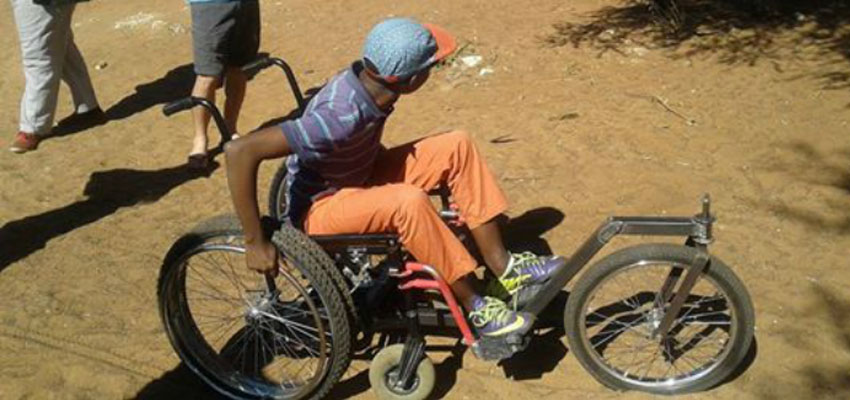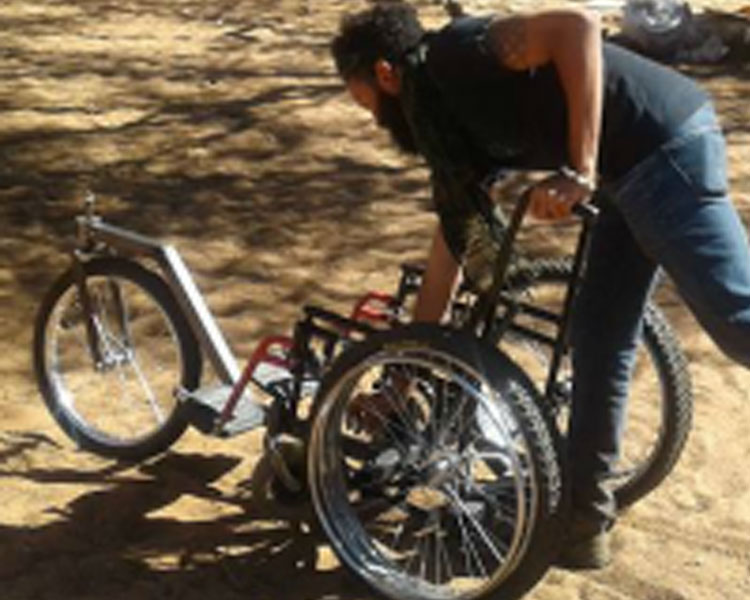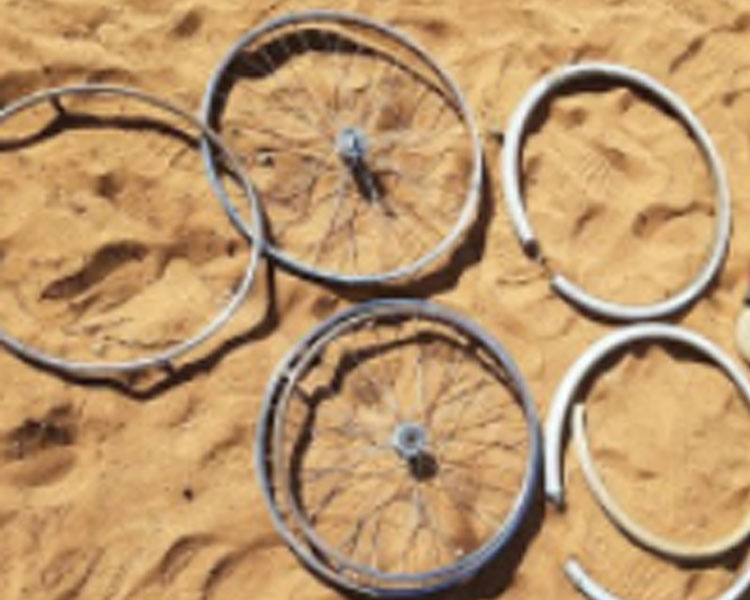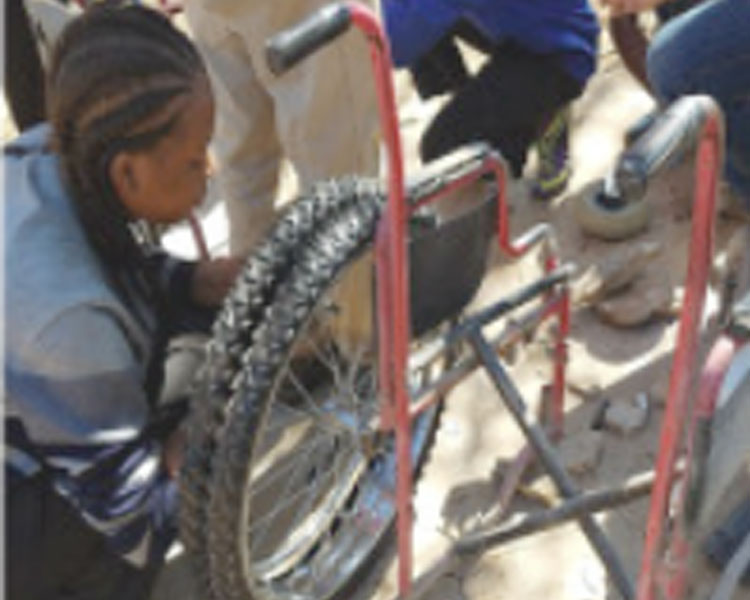
Over the course of a single month, could a team at the 2016 International Design Development Summit in D’Kar (IDDS Botswana) do something to help disabled people around D’Kar get out of their homes and into the community?
The terrain in D'Kar, Botswana, in the Kalahari Desert near the border of Namibia, discourages travel by wheelchair. Deep, loose sand—exhausting even to walk in—bakes in the sun and hides scattered thorns of every description, from thumbtack-size thistles with a single barb in the center to slim, fallen branches radiating dozens of hardened needles the length of a little finger. Yet people with disabilities live here, as they do everywhere human beings are found.
IDDS Botswana—a month in the Kalahari Desert—was my first IDDS experience. The summit was the second in the area collaborating with the San community. The San, traditionally nomadic hunter-gatherers now living within boundaries set by private land ownership and government modernization policy, seek to create new options for their survival and prosperity. The D’Kar summit was supported by entrepreneurs, innovators, and educators from other communities around Botswana, all passionate about innovation as a means to create new alternatives beyond the diamonds and tourism that had brought wealth to Botswana in the past. Further participants and organizers would come from all over the world.
Having taught at D-Lab for the last three semesters, I had begun to understand D-Lab’s approach to design and development in which teams of engineers work closely with people in the developing world to collaborate in ways that play to the strengths of each. However, until this summer I had never experienced a summit. So I applied to be a design facilitator for IDDS Botswana, a role that would require me to help a diverse group of individuals to work together to solve a difficult, real-world problem.
Prior to the summit, D-Lab Founder Amy Smith had worked closely with San community members and International Development Innovation Network (IDIN) members in Botswana to create a shortlist of projects with potential for real impact in the community. One issue that had been suggested by Xhigae, a senior community member, was that people with disabilities which require a wheelchair faced a special challenge in D'Kar due to the sandy, thorn-filled terrain, compounded by relatively large distances and general scarcity of material resources. After some discussion of alternatives, the community members felt a wheelchair could be a useful device if it was adapted to the D'Kar context.
The team
The team that formed around the deep sand wheelchair redefined my notion of diversity. The eldest was Xhigae, the San elder who had proposed the wheelchair project prior to the start of the summit. Xhigae, a grandfatherly gentleman of indeterminate age carried a slim walking stick of knotted desert hardwood and travelled regularly to all corners of D’Kar. He was joined by two young women from the community, Coexae and Sethunya, fluent like Xhigae in the Naro language, but with additional spoken and written English skills, as well as creativity and shop skills, that became more apparent as they became more comfortable with our team. John from Zambia brought innovation experience and metalworking skills. Ketelelo, a Michigan State engineering student who had grown up in Botswana not far from D'Kar and is fluent in Naro, brought critical communications ability as well as his technical perspective. Haily, a designer from Brown University with a talent for drawing and sketch modeling, grew up in Vietnam. Pierce, a Morehouse graduate and PhD candidate at University of California, Berkeley, had deep experience in student organizations and took group dynamics seriously. Keemenao, the youngest, was a skilled bicycle mechanic hoping to attend engineering school whose talent for mechanical invention was immediately apparent to everyone.
I was assisted in my facilitator role by summit organizer Helen, a quietly confident Ghanaian who had just completed her Mechanical Engineering degree at the top of her class. The team was further supported by 2015 IDDS D'Kar alumnus Aaron, a design professional from San Francisco with years of experience ranging from wheelchairs to bicycle ambulances in Namibia, who came mid-summit to take over from me in the design facilitator role as I had a commitment that conflicted with seeing the project through.
Visiting the community
When we visited disabled members of the D'Kar community in their homes, it was clear the team understood the humanitarian and economic aspects of the challenge we had taken on. From a human rights perspective, people with disabilities who lack mobility devices are for all intents and purposes imprisoned in their own homes. From an economic perspective, these individuals are a squandered resource, human beings who consume food and produce waste, but are prevented from using their minds and hands to their full potential for the aid of the community. In light of these our team chose the name “Hùiku,” a word in the local Naro language which means "helping each other," emphasizing that the community would help people with disabilities become mobile so that those individuals could better help the community.
The pace of the summit was relentless and its goals were ambitious – a befitting use of such valuable people's time. One of the challenges of designing for people with disabilities is the diversity of this seemingly niche user group. We met young children with congenital disabilities who were carried on their mothers' backs, men confined to bed as they sought to endure terminal disease with dignity, and an ancient grandmother who was injured intervening in a violent brawl who had been isolated from her extended family by her resulting disability.
Engaging people with disabilities and narrowing the project focus
Thoughtfully but decisively, the team narrowed its user focus to the category represented by Jephta, a nineteen-year-old man with a mobility impairment caused by a neurological disease that, like a spinal cord injury, left him with neither voluntary movement nor full sensation below chest level. Jephta had a wheelchair that he could maneuver indoors and a cushion to help protect him from the kind of pressure sores that threaten the lives of people with impaired movement and sensation. However, in the deep sand around his home, he could move only with the assistance of two helpers, awkwardly pushing and pulling his chair. Our team gained a rough familiarity with Jephta's environment through home visits, and, through conversations, had a sense of his goals. At this point, the team had only three weeks to create a technology to address his needs, to prove a concept and make enough progress that it could be carried forward by others after the summit ended.
"Nothing About Us Without Us" is a slogan by many organizations of people with disabilities in response to the lack of respect and lack of engagement faced by people with disabilities even from allies seeking to help. And so we sought to include Jephta and his family in our design process from the very beginning, inviting him to mess around building things in the D'Kar Innovation Center where we worked, and soliciting his feedback on our models and concepts. Still, it was all too easy to reduce Jephta to a User not a person. There was one moment where we had the chance to get Jephta's feedback on a full-scale ride-able mockup we had built, and discovered that he couldn't ride it even for a moment without a better means to support his feet. It was a perfect teachable moment for the team about the value of modeling concepts at full scale, about the power of rapid but usable prototypes, and about the value of being able to work on the fly. And so I was consumed by directing a subset of my team to work together to rapidly whip up something safe, robust, and that fit perfectly to Jephta's lower leg and foot while keeping his thigh at the correct angle.
They did it, and watching eight hands and four minds work in unison I was amazed and proud at how quickly our collection of brilliant individuals had become a team. Only when IDDS organizer MK touched my elbow and pointed it out did I even look at the pained expression on Jephta's face. Rather than feeling included in the problem we were solving, he was just enduring it as we messed around with his legs. The personal rapport that team member Keemenao had been able to establish with Jephta saved the day and he continued to be willing to work with us. But it was a stark reminder that Jephta was not a Lower Leg Length, not even an End User. He was a teenage human being. In enlisting his help to address a need that affected him and others like him, we were asking him for access to both his dreams and his harshest realities and we needed to treat that relationship with the greatest respect.
Handing off the project for further development
I left the project to Aaron, a skillful facilitator, and to a team which had given me great confidence in their creativity and capability. From airports and then home I read each subsequent email and viewed each new photo with great delight. Aaron reached out to local wheelchair manufacturers including CE Mobility in Johannesburg who had made Jephta's current chair, and Discare in Lusaka, Zambia, longtime D-Lab allies with the capacity to manufacture experimental technology at small scale.
The team settled on creating a modular set of accessories that would transform a standard wheelchair into a device capable of crossing deep, thorn-filled sand. The device could be propelled efficiently and comfortably by family and friends, or independently by the rider, using components that could be sourced in major cities in Botswana. While the team proved the value of the concept, and set up Keemenao to continue to work locally, I worked with Amy to make the continuation of the project a priority for the D-Lab: Mobilityclass this fall. We plan to further iterate on the IDDS team's work here at MIT, and plan to bring what progress we make back to D'Kar by means of a student trip this January 2017. Meanwhile, our partners at Disacare, University of Botswana and CE Mobility are exploring different business models by which this technology could reach other users like Jephta.
Develoloping a wheelchair, transforming lives
Our collaboration on the deep sand wheelchair, in this place with these partners, reinforced the idea that IDDS is not only about the immediate project results but also about the transformation of the participants. It was a privilege to work on a solution to increase the mobility and capability of an individual young man, in partnership with a community and a nation trying to move in a direction of their own choosing, with participants from all over the world trying to learn from each other and increase our capacity for effective action. The incredible work accomplished in one short month by the members of deep sand wheelchair team, working shoulder to shoulder, day after day, was an inspiration and a challenge for each of us to keep up this world-changing momentum in our individual lives in all of the months to come.




